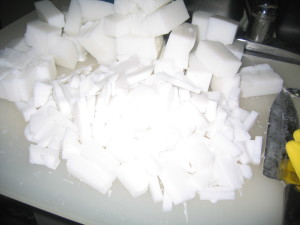Made with Organic Extra Virgin Coconut Oil, its fluffy lather makes it a great laundry and dish soap without drying hands. It suds beautifully even in oily water. Check the recipe bellow for more.
Ingredients
Organic Extra Virgin Coconut Oil: 12 Oz
Distilled Water: 4 Oz
Food Grade Sodium Hydroxide: 2.10 Oz
Lye Discount: 5%
Our 100% Coconut Oil Soap is good for hand laundry and doing dishes. It lathers very well and removes grease out of pan easily. With extra coconut oil in the soap, it does not dry out your hands. I personally shower with it.
Preparation:
Step 1: Wear safety glasses, gloves, and shoes.
Step 2: Have vinegar on hand
Step 3: Weight the distilled water. First weight the container or the cup. Press tare to zero the scale and pour the distilled water in the cup.
Step 4: Weight the Sodium Hydroxide
Step 5: Set the distilled water on the stove with the fan on or in the sink near the window or outside out of kids and pets reach.
Step 6: With caution, pour the Sodium Hydroxide in the water as you stir. Hold your breath for 30 sec to avoid inhaling the fume that will come from the lye solution. Stir for 30 seconds.
NB: Do NOT add water to the Sodium Hydroxide. You will produce a small volcano in your kitchen.
Step 7: After 2 min, return to stir the lye solution again to avoid lye clumps at the bottom of the distilled water.
NB: Place the lye solution near a widow or outside, stand away from the wind direction to avoid breathing the fume from the lye solution.
Step 8: Weight the coconut oil and pour in the pan. If possible, weight directly in the soap pan.
NB: Make the soap in a stainless steel pan (minimum 8Qt for this recipe). The deeper is the pan, the better it is to avoid splatter.
Do NOT use aluminum pan. The lye will eat it.
Step 9: Set on the stove at low heat.
Step 10: Stir the lye solution. Let it cool. If working inside, set the lye solution in the kitchen sink filled with cold water.
NB: Do NOT use the same spoon or spatula to stir the lye solution and the oils. Use silicone spatulas in each one of them or silicone spatula in the lye solution and wood spatula in the oils.
Step 11: Stir the Coconut Oil in the soap pan. As 2/3 is melted, turn the heat off and let the warm oil melt the rest.
NB: Avoid applying excessive heat to your oils. They are quality oils minimally processed and full of nutrients and skin properties that you want in your soap.
Step 12: Stir the oils and the lye solution times to times.
Step 13: Use two different thermometers, measure the temperature of both the lye solution and the oils in the soap pan. The target temperature range is 85 degree F to 100 degree F. The both don’t have to be at the same temperature but they need to fall within that range.
Step 14: When both the oil in the pan and the lye solution reach the same temperature range, rinse the thermometers with vinegar –water solution, wash them and set to dry as well as the spatula used to stir the lye and the container the lye was weighted in.
Step 15: In low stream, pour the lye solution in the soap pan while stirring the mixture in the pan.
Step 16: Grab a whisk and stir for 2 min.
Step 17: similarly to the thermometer, neutralize the lye in the cup, wash it and set to dry.
Step 18: Use a hand blender to blend the soap in the pan at low setting.
Step 19: Blend for 30 sec and whisk for 3 min. then blend for 30 sec again. Alternate blending and whisking the soap mixture.
Step 20: You can take a short break between. It should be fine.
Step 21: Prepare the mold. Line plastic and carton molds with plastic or freezer paper. If recycling oat meal box, grit box or milk box, no lining is needed. This recipe will produce about 183.35 OZ (11.46 Lbs.) of Soap. Therefore choose your mold accordingly.
Step 22: 30 min after the lye was added to the oils; the soap will thicken up and reach a lite trace.
NB: Since the ingredients are high in coconut oil, it could take 1 hour to reach trace.
A trace is a stage where stirring the soap mixture leaves trace or waves, or dent on top of the soap mixture for few seconds. Aim for medium trace to avoid the soap mixture separating in the mold into lye and oil.
Step 23: At medium trace, pour the soap mixture in the mold.
Step 24: After 8 hours, open the mold and tap the soap to check the firmness. If firm, remove from the mold and cut into bars with a knife on a clean surface. If it still soft, let it in a box for 5 more hours. Coconut oil produces very hard soap that is ready to be cut after 8 hours. If you wait too long, it will be hard to cut the soap block into bars.
Step 25: Add the utensils and bowls used in the soap preparation to the pan. Set under the kitchen cabinet or above the top cabinets for at least 3 days before cleaning them. Inside of them will be covered with soap that can be used for their cleaning. Wear gloves to clean them or let them sit for 3 weeks before cleaning.
NB: Generally, the soap needs to be in the mold for 24 hours before you remove it.
Step 26: Cure the soap bars on a stainless rack or in a cartoon box for at least 3 weeks. Every week turn the soap bars to expose all the sides.
Step 27: After 6 weeks, store the bars in a box and close the top to protect them from dust.





Leave a Comment